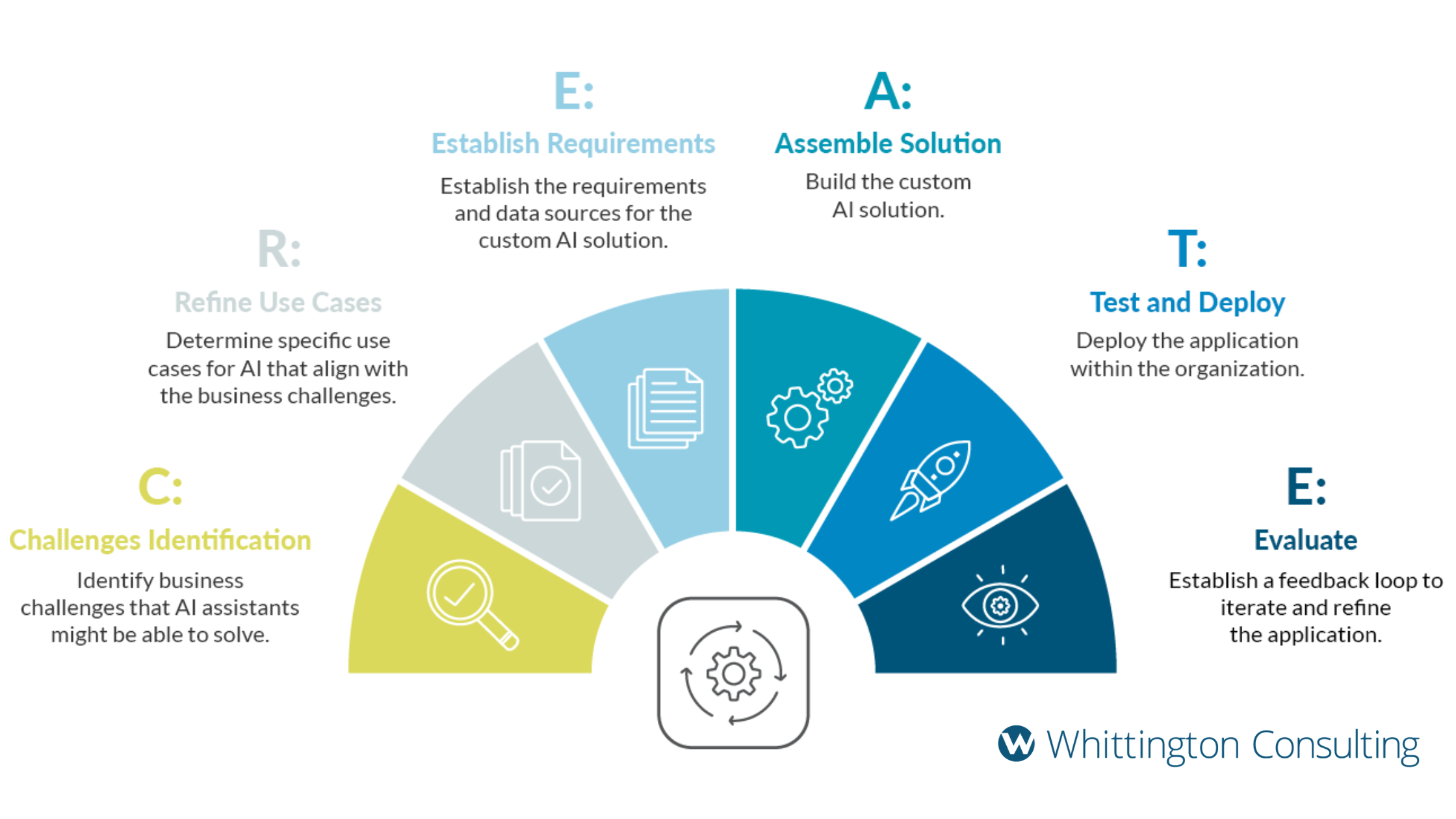The buzz around Artificial Intelligence is deafening. It’s like 2011 when “big data” became a thing, or 2006 when we started hearing about “the cloud.”
For many business leaders, AI is still a big idea with few practical solutions for their businesses. We’re all still trying to figure it out.
Every day, there's a new tool, a new capability, a new headline promising revolutionary change. For marketing leaders and their teams, the pressure is immense – how do you leverage AI effectively while juggling strategic planning, team management, data analysis, and execution? How do you adopt AI without employees wondering if their jobs are at risk? How do you find the time, optimize resources, and stay ahead of the curve?
Other organizations jump headfirst into AI, tasking teams with "finding uses for AI" or building assistants without a clear objective. This often leads to fascinating tech demos but little tangible business value, wasted resources, and ultimately, disillusionment.
The truth is, AI is a powerful tool, but it's not the starting point. The starting point should always be your most pressing business challenges.
At Whittington Consulting, we believe every marketing leader deserves a powerful partner to navigate today's complexities. We've created our own custom AI assistants to use in our digital marketing agency, but we don't start with the technology. We start with you and your specific business needs. To ensure AI delivers real results – unlocking efficiency and strategic insight – we developed The CREATE Framework.
What is the CREATE Framework?
The CREATE Framework is our proven, collaborative process for developing custom AI assistants that are perfectly aligned with your goals. It ensures we focus on solving your specific business challenges first, determining if and how AI can be the most effective solution.
CREATE stands for:
- Challenges Identification
- Refine Use Cases
- Establish Requirements
- Assemble Solution
- Test and Deploy
- Evaluate

The CREATE Framework provides a structured approach to building impactful custom AI assistants.
Let's break down each step:
 C: Challenges Identification
C: Challenges Identification
This is the crucial starting point. Before we even think about AI features, you need to uncover your business challenges.
- Purpose: Identify the core business challenges, bottlenecks, skills gaps, or opportunities where improvement is needed.
- Key Questions To Explore:
- What are the most pressing business issues or challenges you and/or your team are facing today?
- What critical skills are absent or not highly developed on your team?
- What tasks do you wish you had more time for? What do you wish you could do less of?
- Where are you struggling to be effective or do enough?
 R: Refine Use Cases
R: Refine Use Cases
Once you understand the business challenges, it’s tile explore specific solutions. These solutions might include AI, but there are lots of ways to solve business challenges without AI. Not every challenge needs an AI solution, but many repetitive, data-intensive, thought-intensive or analysis-heavy tasks are prime candidates.
- Purpose: Determine specific, high-impact use cases for a potential AI assistant that directly align with the identified business challenges.
- How We Prioritize: We often use a simple quadrant chart, plotting tasks based on the dislike or repetitive nature of a task or skill deficit versus the business impact. Tasks that are highly disliked (or where skills are lacking) AND have a high potential business impact are often the best candidates to tackle first with an AI assistant.
- Output: A shortlist of well-defined, valuable use cases for AI.

 E: Establish Requirements
E: Establish Requirements
With clear use cases defined, the next step is to map out exactly what the AI assistant needs to do and what it needs to work with.
- Purpose: Establish the functional requirements, necessary data inputs, desired output formats, and any existing processes (like SOPs) the AI needs to understand.
- Key Questions To Explore:
- What specifically should the custom AI assistant do?
- What format should the results be in (e.g., summary, bullet points, table)?
- Are there existing Standard Operating Procedures (SOPs) that can be used to train the AI?
- What data exists (documents, spreadsheets, website content, transcripts) that can provide context or be processed by the AI?
 A: Assemble Solution
A: Assemble Solution
This is where the technical build happens, leveraging powerful, existing AI platforms securely. We prefer using existing AI models like OpenAI's ChatGPT, Google's Gemini, or Anthropic's Claude to build AI assistants.
- Purpose: Build and configure the custom AI assistant based on the defined requirements and use cases.
- Technology: Use secure, readily available, subscription-based AI platforms like OpenAI's ChatGPT Plus, Google's Gemini Advanced, or Anthropic's Claude Pro. This is done within your own paid subscription account, ensuring the privacy and security of your conversations and proprietary data. Your information stays confidential within your environment.
- Key Considerations:
- What AI platform is best suited for the specific use case? (Some are better for analysis, others for creative tasks, etc.)
- How will the necessary data be accessed and potentially updated?
 T: Test and Deploy
T: Test and Deploy
An AI assistant is only useful if you and/or your team uses it effectively.
- Purpose: Deploy the assistant within your organization and ensure users are comfortable and proficient.
- Our Approach: This isn't just a hand-off. We typically will provide guided roll-out & training. We ensure you and your team know exactly how to use the assistant effectively, providing clear instructions and best practices, even if you're new to AI.
- Key Questions To Address:
- Who needs access to the assistant?
- Who needs to be trained?
- How long will any pilot or initial testing period last?
 E: Evaluate
E: Evaluate
Continuous improvement is key. We establish ways to gather feedback and refine the assistant over time. As models change, your AI assistant will change as well.
- Purpose: Establish a feedback loop to iterate and refine the AI assistant based on real-world usage and results.
- Key Considerations:
- How will user feedback be collected systematically?
- How will updates or future versions be communicated and rolled out?
What Can a Custom AI Assistant Achieve? (Real-World Examples)
Following the CREATE Framework ensures we build assistants that tackle real needs. Here are a few examples of custom assistants we've built:
- "My Co-Founder": An advisory assistant designed to be a trusted business partner, trained on company context, offering structured, empathetic advice for tough business decisions and helping leaders identify blind spots. (Solves: Need for strategic sounding board, identifying decision risks and blind spots).

- "Customer Persona Generator": Guides users through expert questions to generate comprehensive, best-practice ideal customer profiles (ICPs) based on inputs like website data, interview notes, or existing research. (Solves: Time-consuming persona creation, inconsistent ICP quality, need for deeper customer understanding for marketing/sales).
- "Meeting Notes Summarizer": Transforms transcripts, documents, or even photos of notes into concise, formatted meeting summaries. (Solves: Time spent summarizing meetings, extracting key actions/decisions).
- "Marketing Agency CFO": Analyzes Profit & Loss statements against industry benchmarks, identifying key ratios and suggesting areas for financial improvement. (Solves: Need for quick financial health checks, improving financial acumen).

- "Web Page Analyzer": Reviews a URL while acting as a specific ICP at a specific buyer journey stage, scoring it and recommending content/call to action improvements. (Solves: Ensuring content relevance, optimizing pages for conversion, lack of team expertise in detailed content audits).
These assistants don't just perform tasks; they enhance team capabilities, sharpen strategic thinking, boost efficiency, unlock data insights, and ultimately drive better business outcomes.
Ready to Solve Your Challenges with AI?
Stop chasing AI hype and start solving your real business problems. If you're a marketing or business leader feeling overwhelmed and looking for ways to gain efficiency, unlock strategic insights, or fill skills gaps, a custom AI assistant, built the right way using the CREATE Framework, could be the solution you need.
If you'd like to explore if a tailored AI assistant can help you and your team achieve more, or you'd like to explore getting your own custom AI assistants to solve challenges unique to you or your business, feel free to reach out here.








